
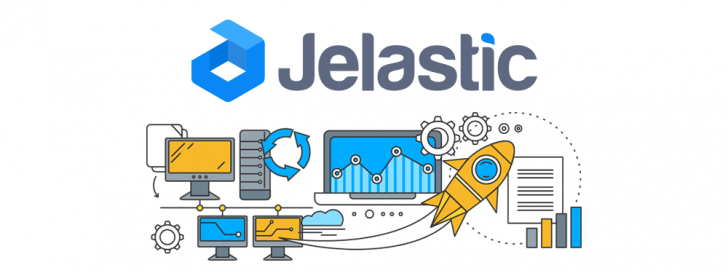
The aim of this cloud platform overview is not to provide a tutorial but to showcase use cases and possibilities to help developers assess if it is a suitable investment for their applications.
Jelastic Cloud is a Platform-as-a-Service (PaaS) for developers.
What is the significance of that?
Jelastic, a platform as a service, provides a comprehensive cloud resource creation and management platform with pre-configured settings that developers can customize as needed.
In a shared hosting environment, users lack visibility into their application’s resource usage and may not be able to easily scale. On the other hand, with a dedicated server, users have full control over resource allocation and scaling capabilities, but setting up and managing the server requires significant time and expertise in server management.
With Jelastic, we can quickly configure web, database, or email servers with just a few clicks, saving time as everything is essentially pre-configured.
With this platform, we can:
- Establish a setting for production or experimentation.
- Replicating an existing production environment.
- Exit a system that is already operational either upward or sideways.
- Initiate or halt an existing and operational environment.
The platform allows us to quickly create and manage the environment with just a few clicks, which is not achievable with Shared Hosting, Dedicated Servers, or VPS.
Locaweb and Websolute
Jelastic is currently located in 45 data centers worldwide and does not operate its own infrastructure in a dedicated data center. Instead, it develops and supplies an infrastructure management platform for leading hosting providers to resell.
In Brazil, there are two companies, Locaweb and Websolute, that offer the Jelastic platform. I have tried it out on Locaweb, but the choice between the two is yours. Both companies provide a trial period before you commit to using their services.
Locaweb offers a 14-day trial, while Websolute offers a 30-day trial. Both hosting platforms have a similar environment, but there may be variations in platform versions, potentially affecting available features. Locaweb is on version 4.9.1, whereas Websolute is on version 4.7.2.
During the free trial period, there are restrictions on resources like cloudlets, the number of environments, and disk space. Private IP and certain setups like FTP and domain pointing are not available for testing during this period. Despite these limitations, it is still beneficial to conduct tests and become familiar with the platform.
The Jelastic Cloud Platform
We will now explore the primary features of Jelastic Cloud and what benefits it offers, now that we are familiar with the platform and where to access it.
Cloudlet
The cloudlet is a unit of measurement for memory and processing capacity in a machine. One cloudlet is equivalent to 128MB of memory and 400MHz of processing power, with values increasing in multiples like 2 cloudlets being 256MB of memory and 800MHz of processing power.

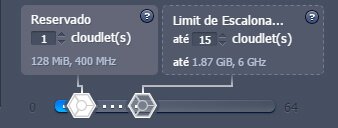
When we establish a server, it will display a bar with two mobile buttons, each of which signifies:
The cloudlets reserved are those that have been allocated to your server. We establish a minimum amount or a small buffer deemed essential for the application to function regularly.
Reserved cloudlets are set aside for peak periods in our application, while dynamic cloudlets are used only when required.
Vertical Getaway
The server can increase its processing power and memory in response to high demand from the application, thanks to vertical scaling. This configuration is done in both reserved and dynamic cloudlets, enabling Jelastic Cloud to adjust resources as needed.
When the 5 reserved cloudlets limit is reached, the system quickly adds dynamic cloudlets until it hits the preset scalability limit. As demand decreases, the additional cloudlets are disabled one by one until the normal number of reserved cloudlets is reached.
Horizontal Getaway
Horizontal staggering involves creating multiple machines that have been previously configured.
Imagine this scenario: you have a WordPress blog running on a web server with Apache and a MySQL database server, each with 5 reserved cloudlets and 10 dynamic cloudlets. Despite increasing the cloudlet numbers to the maximum of 64, the database continues to consume all available resources, causing performance issues.
Jelastic Cloud enables us to duplicate the database machine independently from the Web machine to achieve database load balancing. In this scenario, the second machine will mirror the first machine’s configuration, including the Cloudlet quantity.

chsyys/Burst
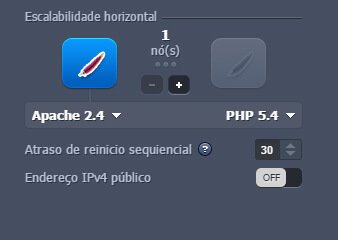
In the Jelastic dashboard, this option is labeled as “No,” and it should not be reserved solely for emergency situations but rather for redundancy purposes. By setting up our web and database environments with two instances each on separate hardware within the data center, we ensure that if an issue arises with one, the other can continue functioning.
We can automatically implement horizontal scaling by setting specific conditions. For instance, if Apache server utilization exceeds 80% for a minimum of 5 minutes, increase by 1 until reaching a maximum of 3 increments.

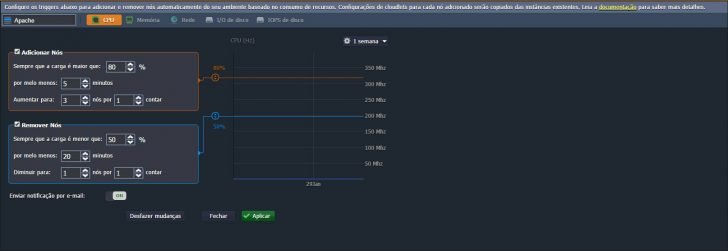
The system monitors your machines constantly. If they are using over 80% of the processing capacity, an additional machine will be added. Conversely, if the server’s processing drops below 50% for at least 20 minutes, one machine will be removed until the minimum number is reached.
This was a simple illustration of how a horizontal scaling rule functions. More intricate rules can be developed by considering additional server metrics like Processing, Memory, Network Usage, Disk I/O, or Disk IOPS. Multiple rules can be generated for each server.
Text: Distributing workloads across multiple servers to optimize performance.
Load balancing is in charge of distributing requests on your website by determining which machine is most available and directing requests to it, or redirecting them to other machines if one is unavailable.
When horizontal scaling is set up, Nginx load balancing is automatically enabled if your environment involves multiple machines. However, you have the option to select Apache, Haproxy, or Varnish for load balancing, giving you the flexibility to choose the server you prefer.
You can customize the memory, processing capacity, and number of load balancing servers in accordance with your requirements by adjusting the Cloudlets and Us settings in addition to selecting the server for load balancing.

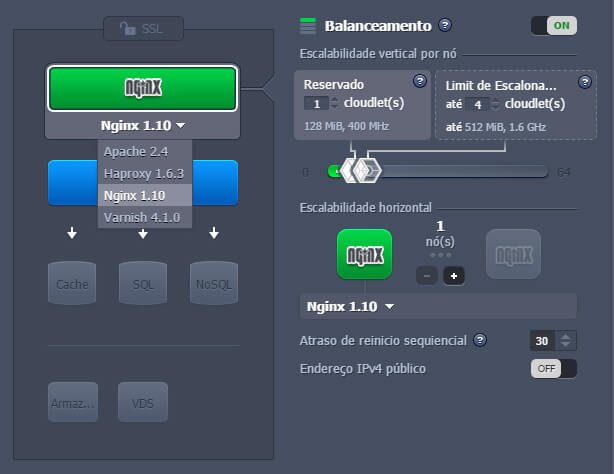
chsyys/iStock
Observing
Jelastic monitoring is undoubtedly the most impressive aspect of the platform that you will utilize on a daily basis. It provides real-time updates on processing, memory, network, and disk data.
Understanding this key feature is essential for identifying the reasons behind the application’s slow performance or investigating user complaints about the app going offline at specific times. By analyzing charts from up to a week prior, we can monitor and optimize our environment during deployment by making necessary adjustments to Cloudlets or Load Balancing. This proactive approach helps prevent resource wastage, cost inefficiencies, and customer disruptions.


Types of Web Servers
Jelastic offers pre-configured web servers for different web languages, including NodeJS and Docker in its environment.
Java programming language
- GlassFish is a software platform.
- Jbossas – Paraphrase
- Jetty.
- Railo
- SmartFoxServer
- Tom’s name.
- Tomcat
- WildFly is a type of software.
PHP programming language
- Apache Server
- Nginx
Ruby programming language
- Apache server
- Nginx is a web server.
.NET Framework
- IIS 8
Python programming language
- Apache server
Types of Database Servers
We can depend on a diverse range of relational and non-relational databases within Jelastic.
Relational databases are systems used for managing and storing data.
- MSSQL 2012
- MariaDB is a type of database management system.
- MySQL is a relational database management system.
- PerconaDB is the subject of the text.
- PostgreSQL is a relational database management system.
Database that is not relational
- Cassandra
- CouchDB is a database system.
- MongoDB document-oriented NoSQL database management system.
- Neo4j is a graph database management system.
- Guide
- Redis
Marketplace

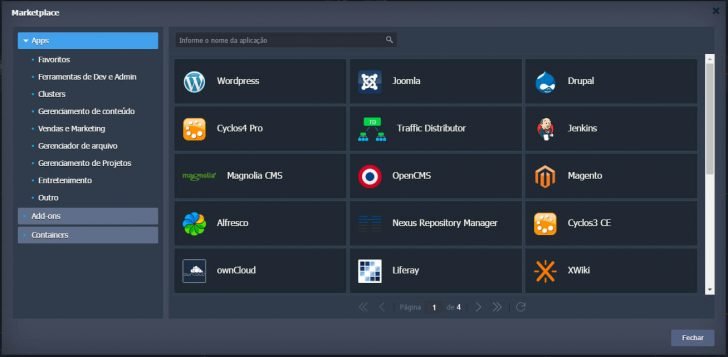
The Jelastic Marketplace offers a variety of popular web applications including WordPress, Joomla, Magento, Wikis, email apps, project management apps, file management apps, and more.
Marketplace was designed to simplify the process of setting up and configuring applications. With just two clicks, users can select the desired application and environment name, allowing for automatic installation and configuration. For instance, selecting WordPress triggers Jelastic to create a basic environment with a Nginx web server and MySQL database server for running WordPress.

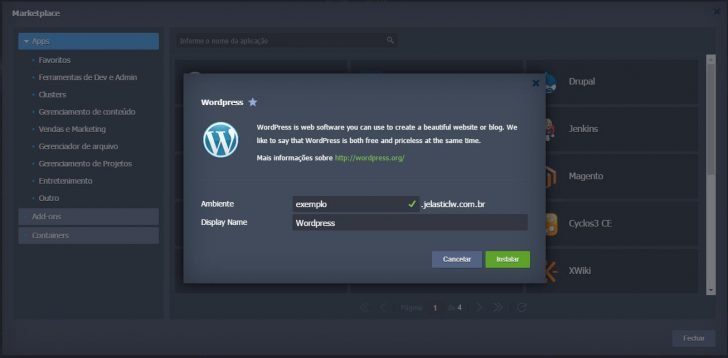
After setting up the environment, the WordPress installation stage is automated. Once the installation process is finished, a window displays the login information for the WordPress admin panel, allowing you to begin working within 10 minutes.

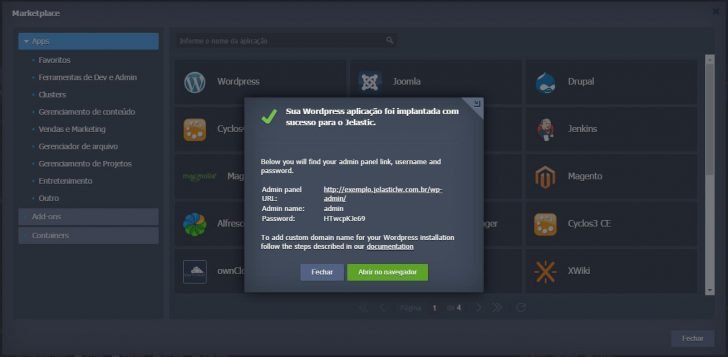
Even with automatic installation, you have the flexibility to modify your setup as needed, such as adjusting server resources, scaling, adding cache, configuring domain and FTP settings. This method also helps save time.
After the setup is finished, you will also get an email containing the database access details and the WordPress admin interface.
System for gathering items
With Jelastic, you are charged based on your usage, including cloudlets, storage space, data transfer, and public IP addresses rented for each server, all calculated on an hourly basis.
However, there are certain aspects that require our attention.
I will demonstrate how the platform’s collection system operates. For specific pricing details from each company, it is advised to visit the Locaweb, Websolute, or Jelastic website where all providers are listed along with their pricing. Additional service details can also be found there.
Cloudlets can be either reserved or dynamic in nature.
Reserved cloudlets must be paid for even if they are not utilized. For instance, if we reserve 15 cloudlets but only use 5 in one hour, we will still be charged for all 15 that were reserved.
Dynamic cloudlets will only incur charges if none are in use during peak times. For instance, if an application is utilizing all 15 reserved cloudlets and one additional dynamic cloudlet out of the 10 available, payment will only apply to the single dynamic cloudlet that was used. Charges are calculated from the activation to deactivation of the cloudlet.
Discounts are available when booking cloudlets, with the discount amount increasing as the number of cloudlets on your server increases (specific rebate values differ by provider).
Disk capacity
You will be charged for the disk space used per hour on each server. For example, if your web application uses 1 GB and the database server uses 2 GB, the total usage would be 3 GB per hour. Up to 2 GB of disk space is free at Locaweb.
Network Data Flow
External network traffic consumed by your application is billable on an hourly basis, including all requests like uploads and downloads. Locaweb provides up to 1 TB of free network traffic usage, with charges applicable only after surpassing this limit.
Public information
A public IP is required for directing a domain to the environment set up in Jelastic, establishing an FTP, and connecting to a database server. The public IP incurs an hourly charge.
In summary
Jelastic Cloud is a solution for applications with fluctuating access levels, such as e-commerce sites that experience spikes during promotional events like Black Friday. Scaling the environment easily and quickly during peak periods helps prevent disruptions and financial losses.
The developer does not require extensive knowledge of server setups and management because the platform offers pre-configured technologies that can be easily installed with a single click to run applications.
You do not need to be concerned about the investment amount as you are charged based on your usage. Jelastic Cloud can be a suitable option even for basic applications.
Published on 08/02/2017 with an update on 28/04/2020.
Concepts are identified by tags.
